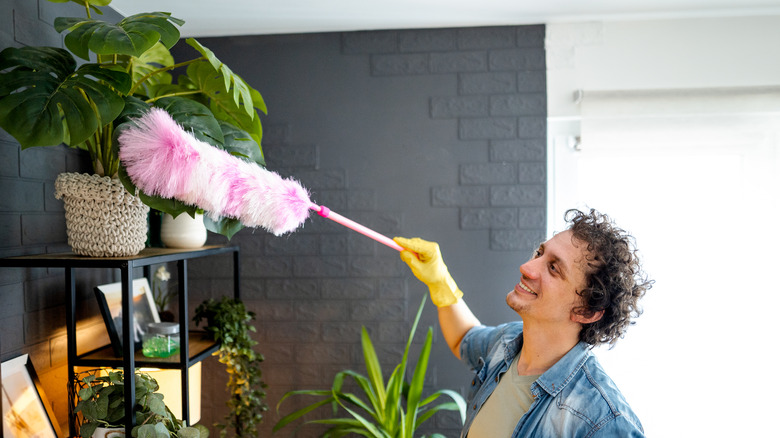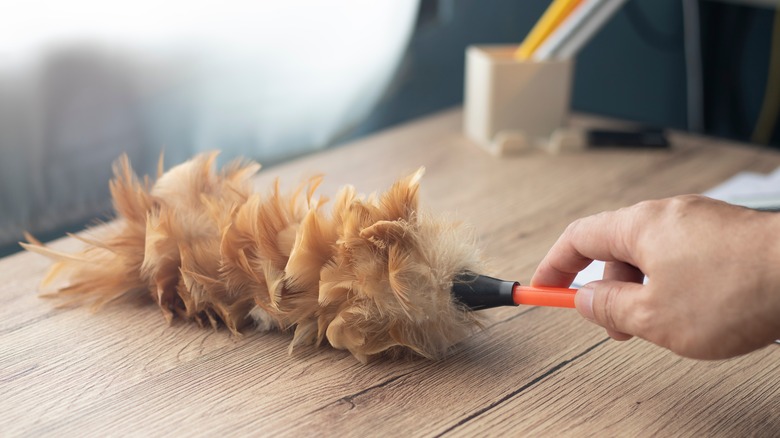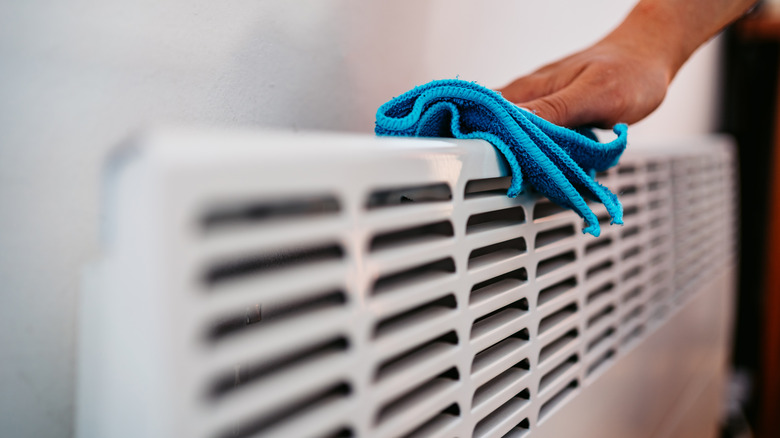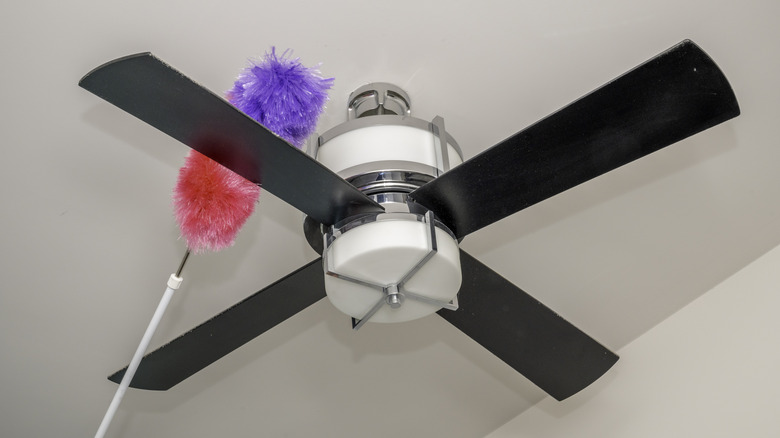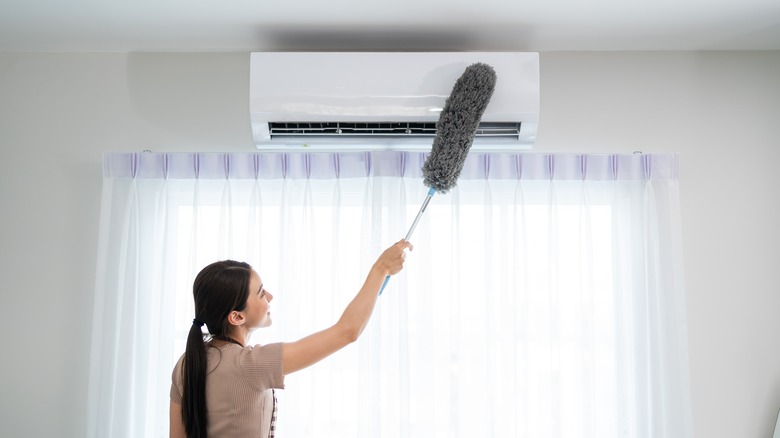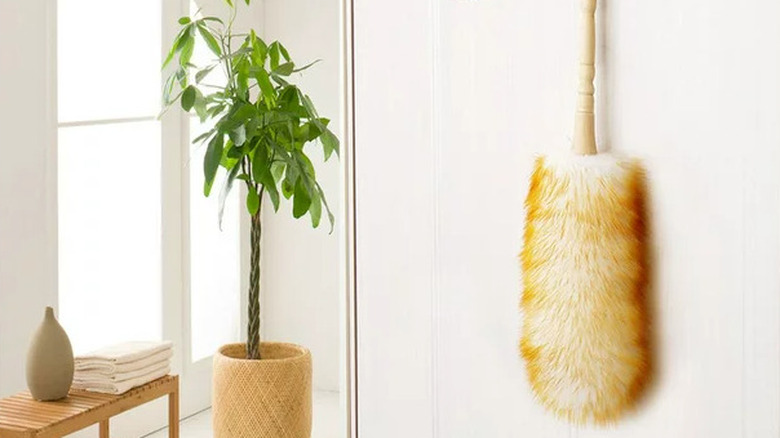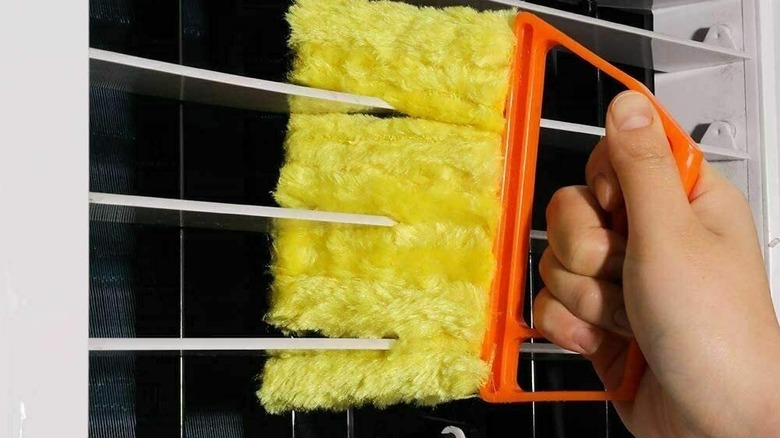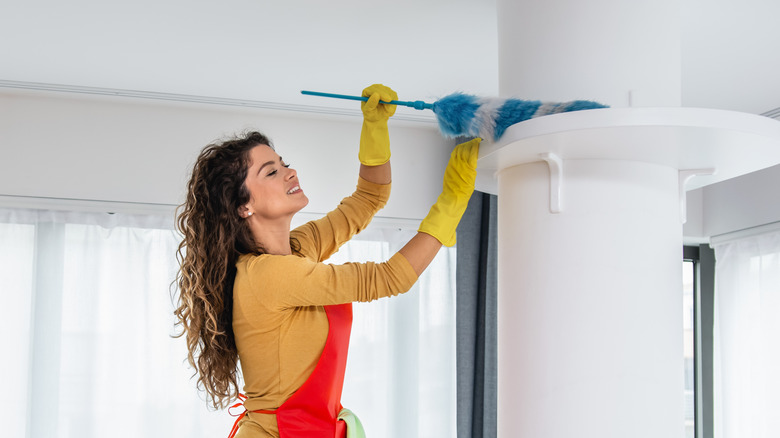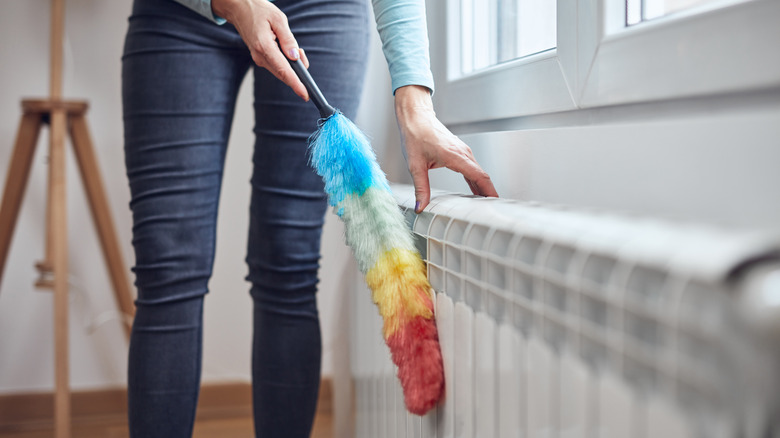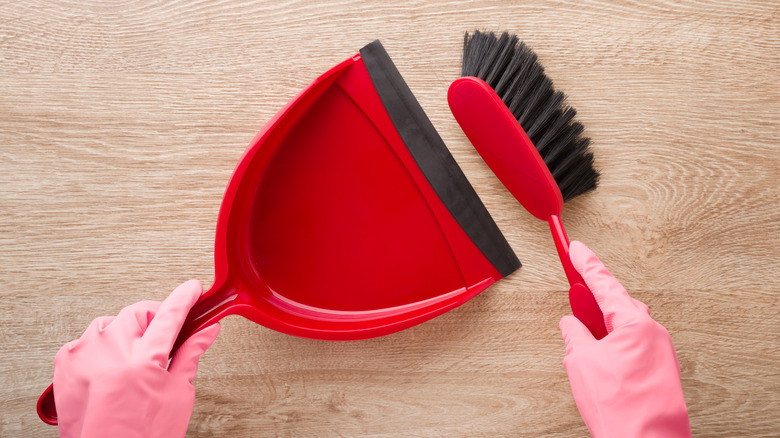Tips On How To Clean Your Duster
We may receive a commission on purchases made from links.
Cleaning your dusters on a regular basis is an essential task that often goes overlooked. Not only does it help maintain its lifespan, but it also promotes a healthier living environment by removing dust, dirt, and allergens. According to Scrubs Home Cleaning, neglecting to dust can lead to health issues such as asthma attacks and respiratory problems, harm to electronics, and make your home less appealing. Failure to clean your duster can spread, rather than clean, these particles.
The cleaning method depends on the type of duster itself, but the process is relatively simple and easy to follow. Different materials may require different cleaning methods, such as a microfiber duster versus a feather duster. By regularly cleaning this tool, you not only prolong its lifespan but also help it remain efficient in removing dust and other particles from your home. You want to ensure your it is always in good condition and ready to use whenever you need it, so we're sharing tips on how to clean your duster, no matter which one you use.
Cleaning feather dusters
Feather dusters have been a popular cleaning tool for centuries, and they are known for their ability to easily trap and remove dust from surfaces. They are typically made with natural ostrich feathers, which are arranged to create a soft and fluffy brush. This makes them perfect for cleaning delicate objects like picture frames, lampshades, and decorative items. Feather dusters are also useful for cleaning hard-to-reach areas like the tops of shelves, ceiling fans, and light fixtures. However, using a dirty one can do more harm than good.
To clean it, you'll need some lukewarm water and a small amount of mild detergent, such as dish soap or wool wash. Avoid using hot water or harsh chemicals that could damage the feathers. Simply soak them in the soapy water for a few minutes, gently rinse, and squeeze out any excess water. To air dry the duster, lay it flat on a clean towel, ensuring the feathers are fluffed and spread out evenly. You can also hang it upside down from its handle in a well-ventilated area until it's completely dry. A clean feather duster is more effective and efficient, which means you'll spend less time cleaning.
Cleaning microfiber dusters
Microfiber dusters have become increasingly popular in recent years because of their effectiveness in removing dust, dirt, and other particles. Made from tiny fibers much smaller than human hair, these dusters can trap and hold onto dust and dirt without spreading it around. They are versatile and can be used to clean a variety of surfaces, including furniture, floors, and electronics. They're especially useful for those with allergies or asthma, as they can remove microscopic particles that can trigger respiratory issues. While microfiber dusters are known for their ability to effectively clean surfaces, they need to be cleaned regularly to maintain their effectiveness.
The good news is they can be hand-washed or thrown in the washing machine. For hand-washing, simply use warm water with a few drops of mild detergent or soap. Let the duster soak for 15 to 20 minutes before rinsing it under water, squeezing out the excess, and removing as much soap as possible. Lay it on a towel to air dry or clip it to your clothing line on a warm day. If you're putting it in the washing machine, use the gentle cycle and avoid using fabric softener or dryer sheets, as these can coat the microfibers and reduce their effectiveness. You can then place it in the dryer on a low heat setting to expedite the process. Never use a damp duster as this can lead to the growth of mold and bacteria.
Cleaning ceiling fan dusters
Ceiling fan dusters are specifically designed to clean ceiling fans, which can quickly accumulate dust and debris. These dusters typically consist of a long handle with a brush or duster head attached at the end, making it easier to clean other hard-to-reach spaces like the tops of bookcases, window ledges, and air vents without needing a ladder. Cleaning a ceiling fan duster is fairly straightforward, but following the manufacturer's instructions is important to ensure that you don't damage it. Some dusters can be washed in the washing machine, while others need to be hand-washed.
For a simple hand-washing process, you'll need first to remove the duster from its handle or extension pole and then shake it outdoors to get rid of any remaining debris. Fill a bucket with warm water and a teaspoon of mild detergent, such as dish soap or laundry detergent. Don't use water that's too hot, as that can damage the fibers. Submerge the duster into the soapy water and gently agitate it to loosen any dirt that may be stuck to the fibers. After 15 to 20 minutes of soaking, rinse the duster thoroughly under running warm water, squeezing out any excess as you go and ensuring most of the soap is gone. Finally, hang the duster up to air dry completely before storing it away, though not in direct sunlight. If the duster head is detachable, you may be able to replace it when it becomes worn or damaged.
Cleaning cobweb dusters
Cobweb dusters are designed to remove cobwebs and other debris from hard-to-reach areas, such as corners, high ceilings, and window frames. Most of them have a long handle with a soft, fluffy head that bends and flexes to fit into tight spaces. Cobweb dusters are also useful for removing dust and debris from other spaces that may be difficult to clean with a regular duster. Most of them can be hand-washed with soap and water, though it's important to avoid using harsh chemicals like bleach as it can damage the duster's effectiveness.
Cleaning a cobweb duster is fairly easy and isn't much different than cleaning a ceiling fan duster. First, remove the duster from its handle or pole and shake out any dust or debris that may still be clinging to the fibers. Next, fill a sink or bucket with warm, soapy water and soak the duster, agitating it to loosen any other dirt. This also ensures the soap gets to every area of the duster. Once it has been soaking for 15 to 20 minutes, rinse it under warm water, removing as much excess water and soap as possible. Allow it to air dry completely before putting it away or using it again.
Cleaning lambswool dusters
Lambswool dusters are a popular choice for those who want to effectively dust and clean their homes without damaging surfaces. The natural lanolin found in the wool helps to attract and hold dust particles, making it an excellent tool for cleaning delicate surfaces such as picture frames, knick-knacks, and other items that can easily be scratched or damaged. Cleaning a lambswool duster is important to prolong its lifespan and keep it in good working condition.
To clean the duster, gently shake it outside to remove any loose debris. Then, use a few drops of mild dish soap or a gentle detergent like WoolLite and lukewarm water to wash the wool, taking care not to agitate or twist the fibers too much. Do not use hot water, bleach, or fabric softeners, as these can damage the delicate fibers. Rinse the duster thoroughly, and gently squeeze out any excess water. Finally, shape the wool back into its original form and allow it to air dry in a well-ventilated area. Avoid wringing or twisting the duster too harshly, or else you can break or misshape its natural appearance.
Cleaning window blind dusters
Window blind dusters are designed to clean the slats on window blinds quickly and efficiently. They are typically made of microfiber, which attracts and holds onto dust and debris without the need for any cleaning product. The dusters are also designed to fit in between each of the blinds' slats, ensuring a thorough clean. They are an excellent tool for those who want to clean their blinds without having to take them down, making them a time-saving solution for a task that can often be tedious. And cleaning these dusters is relatively straightforward.
Start by shaking off any loose dust and debris outside. If your duster is machine-washable, toss it in the washing machine on a gentle cycle with a mild detergent. Alternatively, you can hand wash it with a few drops of mild soap and warm water. Once cleaned, allow it to air dry thoroughly before using it again. You can also create a DIY dust repellent that can be used on window blinds in conjunction with the duster. To make this, you'll need to combine 1 part fabric softener with 4 parts of water into a spray bottle. When you clean your blinds, spray the solution onto the duster and clean as usual to reduce the static cling on your blinds.
Cleaning static duster
Static dusters, also known as electrostatic dusters, attract and hold onto dust and debris with the power of static electricity. They are typically made of synthetic materials such as polyester or nylon, which have been treated with a special coating to create a static charge. Static dusters are excellent for cleaning hard-to-reach places such as ceiling fans, high shelves, and corners, as they can trap dust particles without the need for any cleaning solution. They are also reusable and can be easily washed and maintained for continued use.
Cleaning a static duster is relatively simple. Start by gently tapping the duster outside to remove any loose dust and debris. Then, use a teaspoon or two of mild soap and warm water to wash the duster, being careful not to wring or twist it, which can damage the synthetic fibers. Rinse thoroughly under running warm water and shake off any excess water before air-drying the duster. Alternatively, some static dusters can be machine washed on a delicate cycle, but be sure to check the manufacturer's instructions before doing so.
Cleaning synthetic dusters
Synthetic dusters, as the name suggests, are made of synthetic materials such as microfiber, polyester, or nylon. They are a popular choice for cleaning as they are effective at trapping and holding onto dust and debris, making them ideal for use on furniture, floors, and other surfaces. Synthetic dusters can come in a variety of shapes and sizes, including handheld and extendable options, making them versatile tools for cleaning in a range of spaces. They are also machine washable, making them easy to clean and maintain for continued use.
To properly clean a synthetic duster, start by shaking it out to remove any loose dust and debris. If the duster is particularly dirty, you can rinse it under running warm water to help dislodge any stubborn particles. Then, either wash the duster by hand using a few drops of mild detergent and warm water or machine wash it on a gentle cycle. Always check the manufacturer's instructions for washing and drying to ensure the duster retains its shape and effectiveness. Once the duster is clean and dry, you can fluff it up by running your fingers over the fibers to restore its texture and shape.
Cleaning natural bristle dusters
Natural bristle dusters are made from the soft and flexible hairs of animals, such as horses, goats, or boars. They are typically used for delicate surfaces, such as wooden furniture, that require a gentle touch to avoid scratches or damage. The natural bristles can attract and hold onto dust and other small particles, making them effective for cleaning hard-to-reach areas such as intricate carvings or crevices. They can be found in a range of sizes and shapes, from handheld to extendable, making them a versatile tool for cleaning a variety of surfaces.
Properly cleaning a natural bristle duster is essential to maintaining its effectiveness and longevity but requires extra care so you don't damage the bristles, which tend to be more delicate than other dusters. Begin by shaking it out to remove any loose dust and debris. You can gently wash it by hand using warm, soapy water to remove any extra dust or dirt. Rinse it and squeeze any excess water out before allowing it to air dry completely. Avoid using hot water or harsh detergents, as these can damage the natural bristles and reduce their effectiveness. It's also important to store the duster in a cool, dry place to prevent mold or mildew growth.
